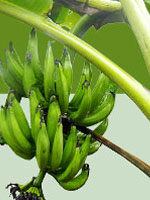




Products & Services

Products & Services ďż˝ Package of Practices



| Banana |
 Botanical
Name: Musa spp. Varieties: Nendran: Manjeri Nendran:Early maturing, low height, comparatively high yielding Kaliyethan:Common variety in Trivandrum district Nedunendran:Fruits are bigger in size, high yielding Chengazhikkodan:Fruits are tasty and golden yellow in colour Attunendran:Suitable for rain fed crop Mettuppalayam:Tall variety, high yielding, long duration Mindoli:Late maturing, Fruits are bigger in size. Zanzibar:Very big fruits, with two – three hands in a bunch, lacks male inflorescence Big Ebanga:High yielding.Does not have male inflorescene. Table varieties: Robusta, Palayankodan,, Poovan, Njalipoovan, Kadali, Chenkadali, Dwarf Cavendish, Karpooravally, Poomkalli, Koompillakannan, Chinali, Virupakshi. Culinary varieties: Monthan, Batheesa, Nendrapadathy Climate & Soil: Tropical humid climate, Well-drained soils with good fertility Season: April-May , August-September and October.Adjust the time of planting so as to avoid high temperature and drought at the time of emergence of bunches. Seed rate: Seed Treatment: Remove the roots and outer skin of the rhizomes. Dip them in a solution of Chlorpyriphos @ 2.5 ml/l for 20mts. Drain the solution. The rhizomes are to be smeared with cowdung solution and ash and dried in the sun for about 3-4 days and stored in shade up to 15 days protecting from rain before planting. Spacing: Pit size 50 x 50 x 50 cm Nendran(pure)- 2m X 2m Poovan, Chenkadali, Palayankodan, Monthan - 2.1 x 2.1 m Robusta - 2.4 x 1.8 m Tissue culture banana - 2mX2m Nutrient management : In order to adjust the acidity in the soil, apply lime at the rate of 500g to 1 kg. Apply Organic manure @10 kg/plant, NPK - 190:115:300g/plant Tissue culture Nendran banana: Apply Organic manure @20 kg/plantNPK- 300:115:450 g/plant in 6 splits. Crop Management: Pest Management :
Yield: 20- 35 t/ha |
| |